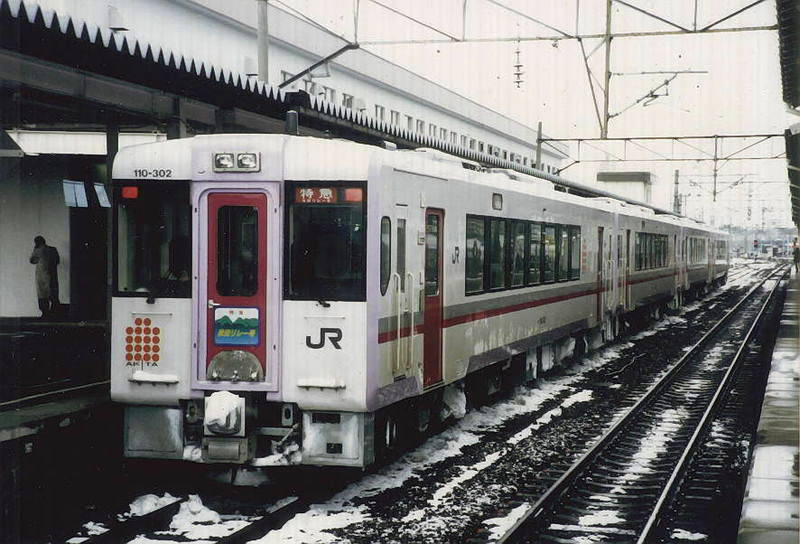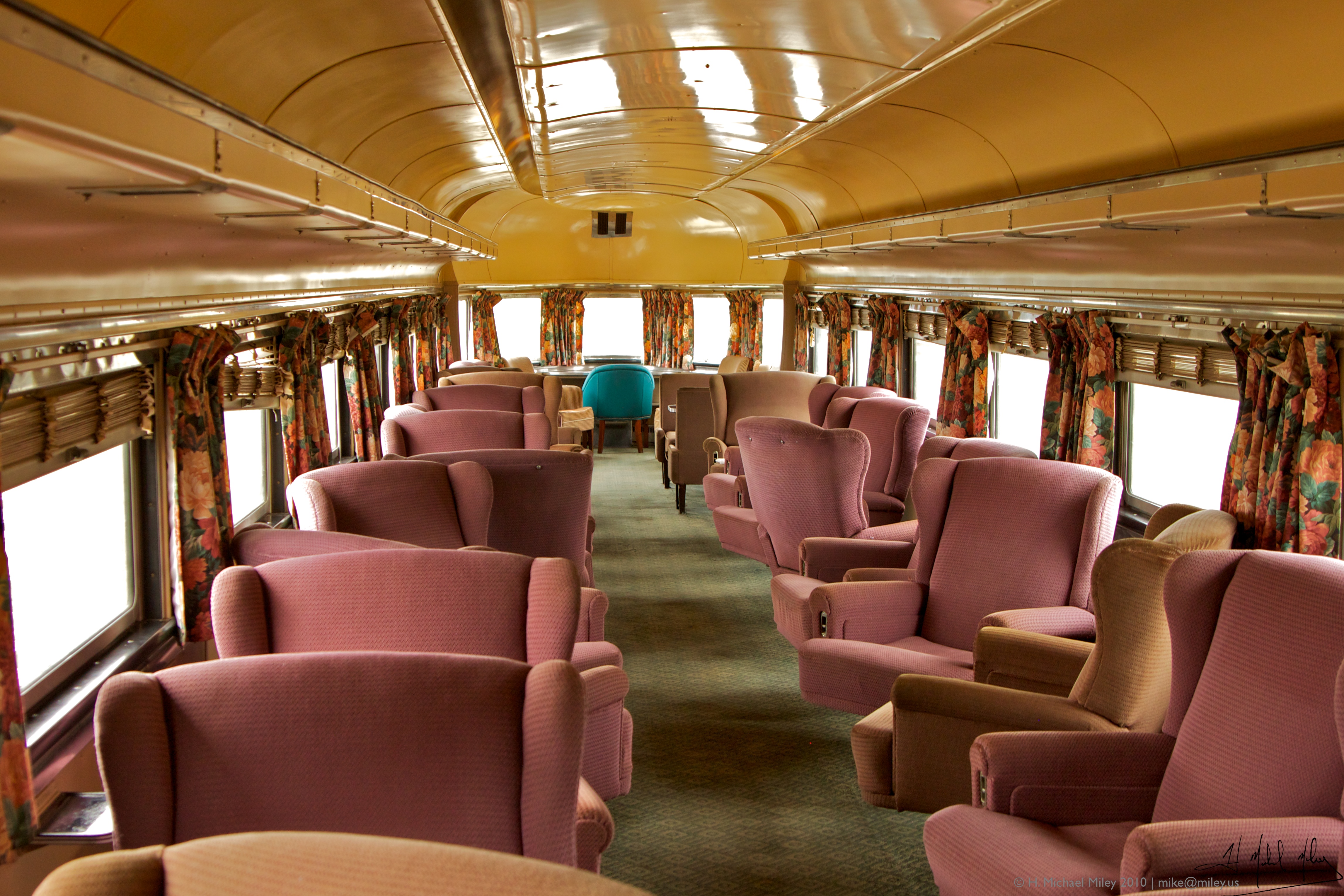|
Akita Relay
The was a limited express train service operated by East Japan Railway Company (JR East) in Japan between March 1996 and March 1997. Engineering work to convert the Tazawako Line between Morioka and Ōmagari from narrow gauge to standard gauge for use by Akita Shinkansen services entailed the complete closure of the line between March 1996 and March 1997. The ''Tazawa'' limited express services that previously linked Morioka with Akita and Aomori were curtailed to run between Akita and Aomori only, and temporary ''Akita Relay'' limited express diesel services were operated instead between Kitakami on the Tōhoku Shinkansen and Akita via the Kitakami Line and Ōu Main Line. Services commenced on 30 March 1996, with 10 "down" services and 11 "up" services operating daily using a specially built fleet of KiHa 110-300 series DMUs mostly in 4-car formations, but with some 3- or 7-car formations. These trains featured 2+2 abreast unidirectional limited express style seating ... [...More Info...] [...Related Items...] OR: [Wikipedia] [Google] [Baidu] |
Limited Express
A limited express is a type of express train service. It refers to an express service that stops at a limited number of stops in comparison to other express services on the same or similar routes. Japan The term "limited express" is a common translation of the Japanese compound noun ; literally "special express"; often abbreviated as . Although some operators translate the word differently, this section is about ''tokubetsu kyūkō'' trains in Japan regardless of the translation by the operators. This term also includes terms with ''limited express'' in them, such as . There are two types of limited express trains: intercity and commuter. The former type of limited express trains generally use long-distance coaches, equipped better than other ordinary express trains, including reserved seating, dining cars or food and beverage carts, and "green cars" (first class cars). The latter type of limited express train usually incurs no surcharge, but seating is usually first-come, f ... [...More Info...] [...Related Items...] OR: [Wikipedia] [Google] [Baidu] |
Kitakami Station
is a junction railway station in the city of Kitakami, Iwate, Japan, operated by the East Japan Railway Company (JR East), with a freight terminal operated by the Japan Freight Railway Company (JR Freight). Lines Kitakami Station is served by the Tōhoku Shinkansen high-speed line from to , and also by local services on the Tōhoku Main Line and Kitakami Line. It is located 487.5 kilometers from the starting point of the Tōhoku Main Line at Tokyo Station and is also a terminus for the Kitakami Line. Station layout The local portion of Kitakami Station has an island platform and a single side platform. However, the side platform is cut, forming a partial bay platform, so that the platform effectively serves two tracks. The Tōhoku Shinkansen portion of the station has an island platform and a single side platform serving three tracks. All of the platforms are elevated. The station has a ''Midori no Madoguchi'' staffed ticket office. Platforms History The ... [...More Info...] [...Related Items...] OR: [Wikipedia] [Google] [Baidu] |
Railway Services Discontinued In 1997
Rail transport (also known as train transport) is a means of transport that transfers passengers and goods on wheeled vehicles running on rails, which are incorporated in tracks. In contrast to road transport, where the vehicles run on a prepared flat surface, rail vehicles (rolling stock) are directionally guided by the tracks on which they run. Tracks usually consist of steel rails, installed on sleepers (ties) set in ballast, on which the rolling stock, usually fitted with metal wheels, moves. Other variations are also possible, such as "slab track", in which the rails are fastened to a concrete foundation resting on a prepared subsurface. Rolling stock in a rail transport system generally encounters lower frictional resistance than rubber-tyred road vehicles, so passenger and freight cars (carriages and wagons) can be coupled into longer trains. The operation is carried out by a railway company, providing transport between train stations or freight customer facili ... [...More Info...] [...Related Items...] OR: [Wikipedia] [Google] [Baidu] |
Railway Services Introduced In 1996
Rail transport (also known as train transport) is a means of transport that transfers passengers and goods on wheeled vehicles running on rails, which are incorporated in tracks. In contrast to road transport, where the vehicles run on a prepared flat surface, rail vehicles (rolling stock) are directionally guided by the tracks on which they run. Tracks usually consist of steel rails, installed on sleepers (ties) set in ballast, on which the rolling stock, usually fitted with metal wheels, moves. Other variations are also possible, such as "slab track", in which the rails are fastened to a concrete foundation resting on a prepared subsurface. Rolling stock in a rail transport system generally encounters lower frictional resistance than rubber-tyred road vehicles, so passenger and freight cars (carriages and wagons) can be coupled into longer trains. The operation is carried out by a railway company, providing transport between train stations or freight customer faciliti ... [...More Info...] [...Related Items...] OR: [Wikipedia] [Google] [Baidu] |
Named Passenger Trains Of Japan
Named may refer to something that has been given a name. Named may also refer to: * named (computing), a widely used DNS server * Naming (parliamentary procedure) * The Named (band), an American industrial metal group In literature: * ''The Named'', a fantasy novel by Marianne Curley * The Named, a fictional race of prehistoric big cats, depicted in ''The Books of the Named'' series by Clare Bell See also * Name (other) * Names (other) Names are words or terms used for identification. Names may also refer to: * ''Names'' (EP), by Johnny Foreigner * ''Names'' (journal), an academic journal of onomastics * The Names (band), a Belgian post-punk band * ''The Names'' (novel), by ... * Naming (other) {{disambiguation ... [...More Info...] [...Related Items...] OR: [Wikipedia] [Google] [Baidu] |
Shinkansen
The , colloquially known in English as the bullet train, is a network of high-speed railway lines in Japan. Initially, it was built to connect distant Japanese regions with Tokyo, the capital, to aid economic growth and development. Beyond long-distance travel, some sections around the largest metropolitan areas are used as a commuter rail network. It is operated by five Japan Railways Group companies. Over the Shinkansen's 50-plus-year history, carrying over 10 billion passengers, there has been not a single passenger fatality or injury on board due to derailments or collisions. Starting with the Tokaido Shinkansen () in 1964, the network has expanded to currently consist of of lines with maximum speeds of , of Mini-Shinkansen lines with a maximum speed of , and of spur lines with Shinkansen services. The network presently links most major cities on the islands of Honshu and Kyushu, and Hakodate on northern island of Hokkaido, with an extension to Sapporo under constru ... [...More Info...] [...Related Items...] OR: [Wikipedia] [Google] [Baidu] |
List Of Named Passenger Trains Of Japan
This article contains lists of named passenger trains in Japan. Shinkansen (bullet trains) Daytime trains Limited express (partial list) Express Rapid Night trains Limited express Express Rapid See also * Rail transport in Japan References * JR Timetable, December 2008 * * {{reflist List of named passenger trains of Japan Japan Japan ( ja, 日本, or , and formally , ''Nihonkoku'') is an island country in East Asia. It is situated in the northwest Pacific Ocean, and is bordered on the west by the Sea of Japan, while extending from the Sea of Okhotsk in the north ... Named passenger trains ... [...More Info...] [...Related Items...] OR: [Wikipedia] [Google] [Baidu] |
Japan Railfan Magazine
is a Japanese-language monthly magazine for railfans covering the mainly Japanese railways published by Koyusha. It has been published in Japan since 1961. Issues go on sale on the 21st of each month, two months before the cover month (e.g. the March issue is on sale on the 21st of January). Each copy sells for between ¥1,100 and ¥1,200 depending on the number of pages. The magazine reports on railway prototypes, complete with technical plans, photos, maps, graphs, and tables. See also * List of railroad-related periodicals A ''list'' is any set of items in a row. List or lists may also refer to: People * List (surname) Organizations * List College, an undergraduate division of the Jewish Theological Seminary of America * SC Germania List, German rugby unio ... External links * 1961 establishments in Japan Magazines published in Japan Monthly magazines published in Japan Magazines established in 1961 Railway culture in Japan Rail transport magazines ... [...More Info...] [...Related Items...] OR: [Wikipedia] [Google] [Baidu] |
Iiyama Line
The is a railway line in Japan linking Toyono Station in Nagano, Nagano Prefecture and Echigo-Kawaguchi Station in Nagaoka, Niigata Prefecture. It is operated by East Japan Railway Company The is a major passenger railway company in Japan and is the largest of the seven Japan Railways Group companies. The company name is officially abbreviated as JR-EAST or JR East in English, and as in Japanese. The company's headquarters are ... (JR East). Stations Rolling stock * KiHa 110 series DMUs History The Iiyama Railway Co. opened the first section from Toyono to its namesake town in 1921, and extended the line in sections to Tokamachi in 1929, where it connected to the Japanese Government Railways line from Echigo-Kawaguchi which had opened in 1927. The Iiyama Railway Co. was nationalised in 1944, and freight services ceased in 1987. The line sees much snow in the winter. The line uses avalanche fences along steep slopes, snow sheds and has a melting system at level cro ... [...More Info...] [...Related Items...] OR: [Wikipedia] [Google] [Baidu] |
First Class Travel
First class is the most luxurious and most expensive travel class of seats and service on a train, passenger ship, airplane, bus, or other system of transport. Compared to business class and economy class, it offers the best service and most comfortable accommodation. Aviation The First class (aviation), first-class section of a fixed-wing jet airliner is typically toward the front of the aircraft. Many airlines have removed first class altogether from their international flights, offering business class as their highest level of international service. First class passengers are usually allowed into Airport lounge, lounges at airports while they wait for their flights. Railways While first-class travel accommodation is common in intercity public transport rail services, they have become increasingly prevalent for commuters' short-distance daily travel, especially in rapid transit contexts, rather than longer-distance regional rail. Australia Australia has internal rail opera ... [...More Info...] [...Related Items...] OR: [Wikipedia] [Google] [Baidu] |
E217 Series
The is a suburban electric multiple unit (EMU) train type operated by East Japan Railway Company (JR East) in the Kantō region of Japan since 1994. Design Introduced in 1994 to replace the 113 series EMUs running on the Sōbu Line (Rapid) and Yokosuka Line, the E217 series was the first outer-suburban train type in Japan to feature four pairs of doors per side per car. The basic design was developed from the 209 series commuter EMUs. It replaced all the Yokosuka Line 113 series trains by 1999. The trains were built jointly by Kawasaki Heavy Industries, Tokyu Car, and JR East (Niitsu and Ofuna factories). For traction, they use Mitsubishi Electric-manufactured VVVF inverters with IGBT (formerly GTO) switching devices which control Mitsubishi MT68/73 traction motors. The gear ratio is 97:16. Operations * Kashima Line ( Sawara - Kashima-Jingū) * Narita Line (Chiba - Narita Airport, Sawara) * Sōbu Main Line (Tokyo - Narutō) * Sotobō Line (Chiba - Kazusa-Ichinomiya) * U ... [...More Info...] [...Related Items...] OR: [Wikipedia] [Google] [Baidu] |



